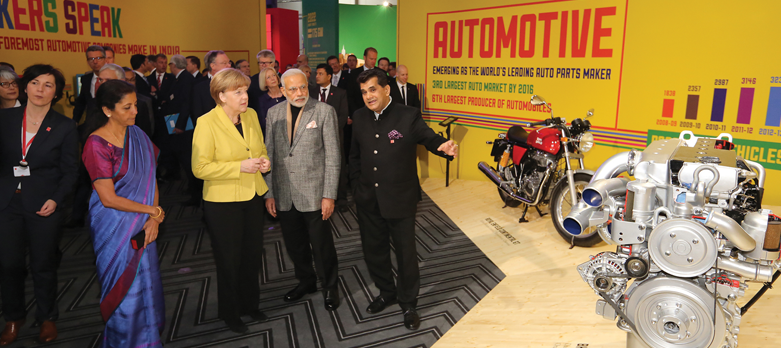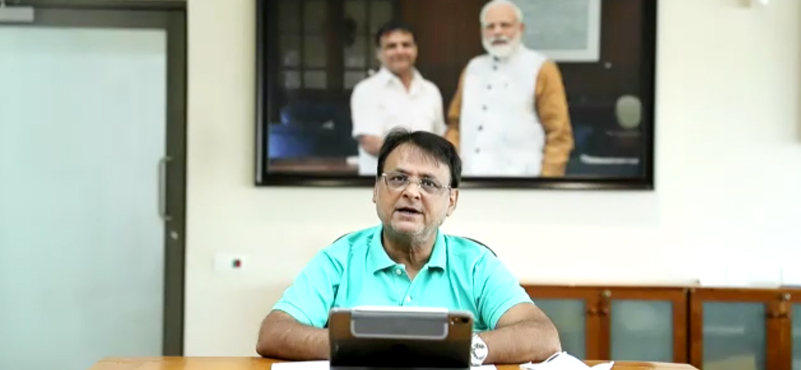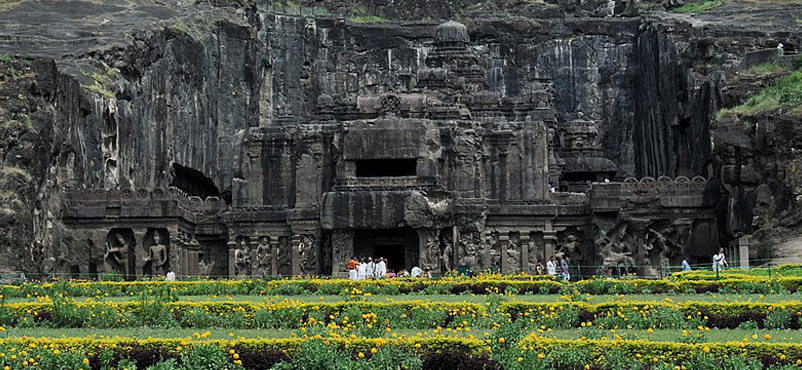Make in India is a major national program that is designed to transform India into a global manufacturing and investment hub. In order to start a movement, you need a strategy that inspires, empowers and enables in equal measure. By replacing ‘Made’ with ‘Make’, an overworked phrase was transformed into a powerful call to action. But the revolution also needed a symbol that combined historical and emotional resonance with a modern and dynamic edge. 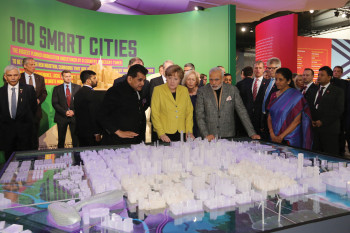 The answer lay in the past – the Lions and Chakra emblem of Ashoka, India’s ‘Emperor of Peace’. The Ashoka Chakra also forms the centrepiece of India’s national flag. It denotes peaceful progress and dynamism – a sign from India’s enlightened past, pointing the way to a vibrant future. The Lion stands for strength, courage, tenacity and wisdom –values that are as India today as they have ever been. By adding a sense of forward movement and using manufacturing elements as graphic texture, the Make in India icon was born.
The answer lay in the past – the Lions and Chakra emblem of Ashoka, India’s ‘Emperor of Peace’. The Ashoka Chakra also forms the centrepiece of India’s national flag. It denotes peaceful progress and dynamism – a sign from India’s enlightened past, pointing the way to a vibrant future. The Lion stands for strength, courage, tenacity and wisdom –values that are as India today as they have ever been. By adding a sense of forward movement and using manufacturing elements as graphic texture, the Make in India icon was born.
This was an India promotion with a difference. Germany has been witness to an annual display for tourism, year after year, at ITB Berlin. But a still bigger performance awaited Germans in particular and the rest of the world at Hannover, to see industrial India, resurgent and buoyant, taking on the world to manufacture in India. In our reckoning, this is business-led travel, opening huge possibilities for increased connectivity and tourism.
Importance of Hannover & Partner Country Concept
The Hannover Fair attracts nearly two lakh global leaders in business, technology, industrial scientists and policy makers. About 300 Indian companies including public sector giants participated in the five day fair, seeking technology collaborations, business tie-ups and showcasing India’s capabilities in global trade. India had been the Partner Country at the Hannover Messe in 2006. With USD 21 billion bilateral trade, Germany is India’s sixth largest trading partner with engagement in the areas of mechanical engineering, automobiles, chemicals, services, nuclear reactors, construction etc.
Garments and textile products, chemical products, leather & leather goods, iron, steel and metal goods, electronic components, electrical components, pharmaceutical products, and auto components are major items of exports from India to Germany. The key German exports to India include electrical generation equipment, auto equipment, complete fabrication plants, bearings, gear equipment, measurement and control equipment, primary chemical products, synthetic material, machine tools, aircrafts and iron and steel sheets, etc.
The Government saw the participation in the fair as an opportunity to increase its global presence in commodities & services, apart from utilizing the event for attracting investments into India as part of the ‘Make in India’ campaign of the Prime Minister.
India at Hannover: Objectives & Strategy
In April 2015, India took centre stage as Partner Country at Hannover Messe, the world’s largest industrial fair. The theme: Make in India, a campaign that has captured the popular imagination and created a surge of renewed interest in India as a global manufacturing hub. A seamless city-wide campaign was built that stretched from backlit posters at Hannover Airport to interactive art installations in the exhibition hall.
At Hannover Messe 2015, India showcased its technological advancements, manufacturing capabilities and investment opportunities to the world. The Indian delegation comprised over 350 companies, 6 ministries, 14 state governments and 120 top Indian CEOs. The India Pavilion blended art, installations and infographics to demonstrate the country’s enormous industrial promise. The Indo-German Business Summit, seminars, presentations and cultural shows punctuated the five days of the event. The result: a spectacular five-day exhibition that generated incredible buzz in the international business community, and – most important of all – a sense of pride amongst Indians everywhere. India’s participation at Hannover Messe 2015 is a clear signal to friends, partners and investors across the world that it’s time to Make in India.
Opening Ceremony
The India segment at the gala opening ceremony was a celebration of the country’s vibrant heritage and industrial prowess. Modern technology met traditional choreography, as yoga demonstrations and classical and folk dances were accentuated by 3D video mapping and augmented reality. The Ashoka Chakra and rangoli, an indigenous art, combined to create the aesthetic. The flavour of the evening was heightened with cocktails and samplers of Indian cuisine, prepared by renowned chefs from the Experience India Society. The showcase stood not only as a tribute to India’s dynamism but also as a living manifestation of its immense capabilities.
Scope & Size of Event
| No. of countries | Over 70 countries |
| No. of exhibitors | 6500 |
| No. of Indian exhibitors | 400 |
| No. of visitors | Over 200,000 and 70,000 foreign |
| Partner Country events | 100 |
Design of the Pavilion
The Make in India pavilion showcased the depth of India’s potential as a manufacturing and investment partner. The pavilion positioned India’s advancements across industrial sectors on the bedrock of its rich culture and idiom. History and memory were the two vital aspects of the design strategy.
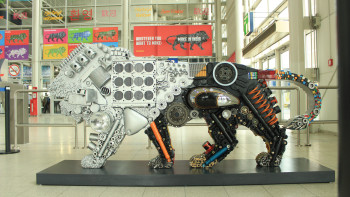 The pavilion’s geometry was rooted in the Navgriha and Vaastu principles, representing India’s profound tradition of peaceful progress. The Chakra, deconstructed to create a four-petal flower form, invoked immediate nostalgia. Each petal transformed into an exhibition pod, with vibrant displays of data, infographics and installations that illustrate the vast range of opportunities India has to offer.
The pavilion’s geometry was rooted in the Navgriha and Vaastu principles, representing India’s profound tradition of peaceful progress. The Chakra, deconstructed to create a four-petal flower form, invoked immediate nostalgia. Each petal transformed into an exhibition pod, with vibrant displays of data, infographics and installations that illustrate the vast range of opportunities India has to offer.
Elements had been extracted from India’s material memory. Indigenous materials such as brass, wood, textile and metal evoke the country’s legacy of craftsmanship. A patterned carpet depicting the dyeing technique of ikat, while the pods, texturized with woven fabric, reminded us of India’s highly skilled chataai weavers. The backdrop walls used the Indian jaali or lattice, rendered in glass and steel to give it a modern edge. Contemporary materials had been utilized to build traditional patterns and motifs, setting the stage for creating new memories and histories. The tea lounge made a distinct design statement, reflecting the environmental thrust of India’s new manifesto and its green initiatives.
The pavilion distilled India’s past, summarized its present capabilities, and envisioned its promising future.
Structure of the Pavilion
An artistic assemblage of infographics and interactive installations that displayed information about the core sectors of the Indian economy – biotechnology, renewable energy, space, wellness, industrial corridors, automotive industry, infrastructure in the north-east region, and skill development, among others. Elements such as digital screens and exhibition-pod walls depicted highly technical data in visually arresting ways. The India pavilion stood out as towering proof of India’s capabilities for potential investors from across the world.
Verticals in the Pavilion
Space: The space section showed India’s credibility as an economical and sure-footed partner in space and aeronautics. India’s space program has embarked on 119 missions, has 26 aircrafts in orbit, partnered with 33 countries and 3 multinationals. On display in the space pod were scale models of the PSLV, GSLV, Cartosat – 2, GSAT-16, Mars orbiter mission.
Automotive industry
Emerging as the world’s leading auto parts maker, the automotive section of the India Pavilion focused on India’s strengths as the 6th largest producer of Automobiles in the world. The rapid growth of India’s automotive industry has generated huge gains in productivity, innovation and profitability. Whatever the category – leisure motorcycling or cargo-carrying, cars or components, domestic manufacture or exports – it pays to make in India.
The automotive section is also dotted by installations of auto manufacturers in India.
Models on display
- The Royal Enfield Continental GT – manufactured in Chennai, India – it uses global parts such as Brembo brakes, Pirelli tires, Paioli suspension, assembles in India and sells in more than 120 countries in the world. In 2014, Royal Enfield surpassed Harley Davidson in global sales. Made in Chennai, for the world.
- The BharatBenz engine OM 906 and the G85 transmission – the two parts successfully demonstrate Daimler’s Make in India story.
The Makers speak listening panel – 8 of the world’s foremost automotive companies that Make in India.
Industrial corridors and India’s smart city vision
The Industrial corridors wall showed cartographs of the 4 Industrial corridors that are being setup in India, namely:
- Delhi-Mumbai Industrial Corridor
Length: 1483 km
Dedicated Freight Corridors connecting industrial nodes to be built by 2017
- Bengaluru-Mumbai Economic Corridor
Length: 1000 km
Diamond quadrilateral high-speed rail link to connect Bengaluru, Mumbai, and major
Metros and growth centres
- Vizag-Chennai Industrial Corridor
Length: 800 km
- Chennai-Bengaluru Industrial Corridor
Length: 560 km
Detailed information of all manufacturing hubs and industries listed out all investment opportunities in the corridors.
Smart city immersive mode
Based on the blueprint of Dholera Special Investment Region (SIR), Gujarat, the installation provided a 24-hour cycle of a Smart City, portraying an integrated approach to improve the efficiency of city operations, the quality of life for citizens, and the local economy.
100 Smart cities vision: This wall focused on India’s biggest planned urbanization in recent times and major expansion of India’s manufacturing infrastructure. Planned alongside the new Industrial corridors designed to decongest India’s major cities, dedicated freight corridors with the world’s lowest logical costs of manufacturing. The focus of these smart cities is on smart governance, local economies, transportation, sustainability, recycling, water & waste management.
IT & BPM
India is the world’s go-to destination for software-to-services expertise, devices, software and IT & BPM services. This section of the India Pavilion focused on the strengths and facts of this sector and also touches on the Digital India initiative and India’s ESDM skills.
Demographic dividend
With the world’s fastest growing working-age population, the demographic dividend section of the India Pavilion showcases India’s skill building initiatives, skill demand and employment projection for 2022. Large graphs and info-graphics helped in delivering this message.
AYUSH (AYURVEDA, YOGA, UNANI MEDICINE, SIDDHA MEDICINE, HOMEOPATHY)
India’s wellness sector with over 2000 years of history, products worth over 600 USD million, over 9000 manufacturing units and potential in skill building with many graduate and post-graduate schools generating thousands of new scholars annually.
Northeast India
Key focus area of India’s infrastructure overhaul plan, this section focused on the untapped potential of India’s north-east.
Defence
The defence wall focused on how India’s defence innovation has led to civil application. A tactical environment is the most demanding research lab in the world and with extensive government support, increased participation of private enterprises and a growing pool of highly qualified human resource finds application and fuels innovation in civil sectors.
The Indo-German partnership wall
The section focused on two of the world’s most progressive democracies – India and Germany and their business partnerships. More than 1500 German companies operate in India and some of the key facts are as follows:
– USD 7.2 billion invested in over 23 years
– USD 1038 million in 2013-14
– 20.7% increase in direct investment in 2014
– 3.2% of total investment inflow
Videos and testimonials of top German companies manufacturing in India played on the screens.
BIOTECHNOLOGY
With over USD 4.3 million in 2014 revenues, India is among the top 12-biotech destinations of the world.
TEA LOUNGE
Created with natural materials such as wood and textiles, the tea lounge reflected the environmental thrust of India’s new manifesto – and its clear commitment to green initiatives and sustainable development. The lounge provided space for partnerships to brew, but it wasn’t all about business: to add to the flavour, renowned chefs from the Experience India Society had been flown in to prepare classic Indian delicacies and beverages for guests. After all, no country makes a better cup of tea than India.
Elements In Pavilion
Lion Installations
Installations included the Make in India icon and various interpretations that it has inspired, including a sculptured lion.
Sculptured Lion: This installation was an artistic rendition of India’s immense industrial capabilities. Its compartments represented the twenty-five core industry sectors of the Indian economy. Natural elements and engineered products had been embedded to depict the vast manufacturing and investment potential of each sector. The lion showcased the spirit of innovation that underscores all enterprise in India.
Automotive Lion: India is the sixth largest producer of automobiles in the world, and this installation is a creative representation of the industry’s immense potential. With a body engineered from Indian-made components, this automotive lion stands proudly as a proof of quality for investors across the world.
IT & BPM Inspired Lion: With the third largest pool of scientists in the world, India’s Electronic System Design & Manufacturing (ESDM) industry is expected to be worth USD 94.2 billion by the end of 2015. A layered piece of art, the lion sculpture incorporates India’s top ESDM products, showcasing the sector’s vast capabilities and opportunities.
Make In India icons
The most photographed installation at the Hannover Messe fair 2015, the Lion stands for strength, courage, tenacity and wisdom—values that are as Indian today as they have ever been. By adding a sense of forward movement and using manufacturing elements as graphic texture, the Make in India icon was born. Another artistic interpretation of the Make in India icon, rendered in a host of coloured gears, was installed to represent the vibrancy of India. The two lions came together to embody the spirit of the revolution – progress and innovation.
Other Installations
3D Model Smart City: A 3D cutaway view of a Smart City, portraying integrated infrastructure to improve the efficiency of city operations, the quality of life for citizens, and the local economy.
Smart City Spread: A Smart City made of glass and light, portraying the government’s integrated approach to improve the efficiency of operations across 100 chosen cities, the quality of life for citizens, and the local economy; models of India’s top satellites and space launch vehicles; and samples of electronics conceptualized or manufactured in India.
Outdoor Ads
The entire experience was supported by a citywide outdoor campaign that reinforced India’s participation at the Messe and highlighted the ‘Make in India’ campaign extensively. The lion icon was used as a mnemonic for all outdoor communication and could be spotted all over the city, from the airport terminals to the city billboards. The focus of this branding exercise was to showcase the various sectors of the Indian economy that foreign investors could bet on. This signage also dominated the Hannover Fair grounds covering the main hall entrances, skywalks and VIP Shuttles. There were outdoor advertisements spread across Munich, Berlin, Frankfurt and Hannover.
Exhibition Events & Activities
Talks and Seminars at the Hannover Messe exhibition included:
- Indo German Business Summit,
- Investment opportunities in Maharashtra and available infrastructure
- Investment opportunities in Andhra Pradesh
- Make in India: Opportunities in Electronics & Electricals segment
- Smart Cities: The Urban Challenge
- Investment opportunities in Punjab
- Market Potentials and Business Applications for Renewable Energy in India
- India-Germany: Towards a Strategy Skilling India
- Heavy Engineering & Motion Drive and Automation
- Investment opportunities in Gujarat
- Indo-German Collaboration on Digital India
- Investment opportunities in Rajasthan
- Investment opportunities in Uttar Pradesh
Social Media Activities
The offline campaign was backed up by Make in India’s trademark social media reportage – an online movement that connects millions of friends and followers to exciting India-related events as they unfold across India and the world. Several social media channels such as Facebook, LinkedIn, YouTube and Twitter were used effectively to amplify India’s role as the partner country at the Hannover Messe. During the opening day of the Messe in Germany, Make In India’s twitter handle received over 13.5 million impressions globally. The Make In India Twitter handle reached out to more people on the opening day of the Messe than any other month prior. Digital campaigns on high traffic websites like The Financial Times, Reuters and The New York Times reached out to Entrepreneurs, C-suite executives and decision makers from various industry sectors worldwide and helped increase the awareness of the Make In India initiative. Google Maps also documented the India pavilion at Hannover Messe.
Feedback and Outcome of Hannover
MoUs signed on account of the Hannover Messe exhibition included:
- India signed 2 MoUs with Germany & 1 each with Bulgaria, Switzerland & Russia.
- HMT inked an MoU with FT Machine Tools, Germany to manufacture flow forming machines in India
- REIL signed an MoU with Bulgaria-based Milkotronics Ltd to manufacture milk analyzers in India
- HMT signed an MoU with Swiss-based Num Controls to manufacture CNC control, systems & drives
- Instrumentations Ltd & German firm KE Kauer inked an MoU to manufacture control valves in India
- HMT inked an MoU with German based Enit GmbH to provide total engineering solutions in India.

